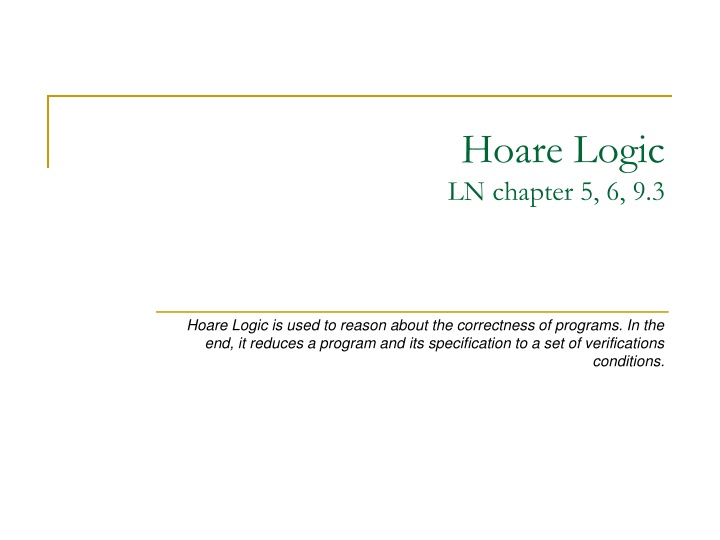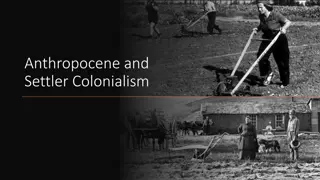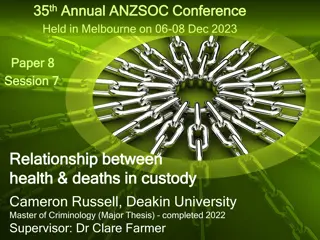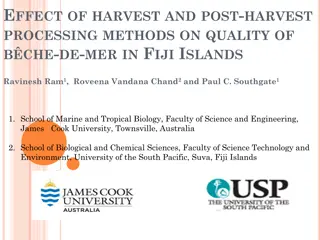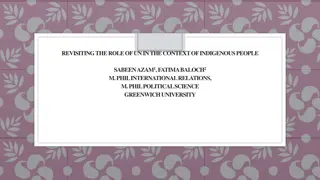Challenges Faced in Indigenous Studies at University of Fiji
Student inclusion and retention, interdisciplinary teaching, internationalization of programs, and social behavioral strategies for intervention are key challenges faced at the Centre for iTaukei Studies, University of Fiji. The center aims to enhance client satisfaction, industry collaboration, and community engagements while striving for academic excellence and cultural preservation.
Download Presentation

Please find below an Image/Link to download the presentation.
The content on the website is provided AS IS for your information and personal use only. It may not be sold, licensed, or shared on other websites without obtaining consent from the author.If you encounter any issues during the download, it is possible that the publisher has removed the file from their server.
You are allowed to download the files provided on this website for personal or commercial use, subject to the condition that they are used lawfully. All files are the property of their respective owners.
The content on the website is provided AS IS for your information and personal use only. It may not be sold, licensed, or shared on other websites without obtaining consent from the author.
E N D
Presentation Transcript
Hoare Logic LN chapter 5, 6, 9.3 Hoare Logic is used to reason about the correctness of programs. In the end, it reduces a program and its specification to a set of verifications conditions.
Overview Part I Hoare triple Rules for basic statements Weakest pre-condition Example Part II : loop Handling few more basic constructs array specification at the program level // SEQ, IF, ASG 2
Hoare triple A Hoare triple is a simple way to specify the relation between a program s input and end result. Example: {* y 0 *} Pr(x,y) {* return = x/y *} the program being specified post-condition pre-condition Meaning: if the program is executed on a state satisfying the pre-condition, it will terminate in a state satisfying the post- condition. (so-called total correctness interpretation ). 4
Partial and total correctness interpretation {* P *} Pr(x) {* Q *} Total correctness interpretation of Hoare triple: if the program is executed on a state satisfying P, it will terminate in a state satisfying Q. Partial correctness interpretation: if the program is executed on a state satisfying P, and if it terminates, it will terminate in a state satisfying Q. Partial correctness is of course less complete, but on the other hand easier to prove. Useful in situations where we can afford to postpone concerns about termination. 5
Difficult to capture with standard Hoare triples We have to note that Hoare triples have limitation. Not every type of behavioral properties can be (or can naturally be) captured with Hoare triples. Examples: Certain actions within a program must occur in a certain order. An alternative formalism to express this: CSP A certain state in the program must be visited infinitely often. Alternative formalism: temporal logic. A certain goal must be reached despite the presence of adversaries in the program s environment that may try to fake information. Alternative formalism: logic of belief. 6
Hoare Logic Hoare Logic is a logic to prove the correctness of a program in terms of the validity of Hoare triples. It provides a set of inference rules like the one below, to decompose statement sequence (SEQ Rule): {* P *} S1 {* Q *} , {* Q *} S2 {* R *} ----------------------------------------------------------------- {* P *} S1;S2 {* R *} 7 7
Inference rule for IF {* P/\ g*} S1 {* Q *} , {* P/\ g*} S2 {* Q *} -------------------------------------------------------------------------- {* P *} ifgthen S1else S2{* Q *} {* P /\ g *} S1 {* Q *} S1 P g Q g S2 {* P /\ g *} S2 {* Q *} 8 8
Inference rule for assignment, attemp-1 ?? -------------------------------- {* P *} x:=e{* Q *} Idea: let s first construct a pre-condition W, that holds before the assignment, if and only if Q holds after the assignment. Then we can equivalently prove P W 9 9
Examples {* W? *} W: 10=y x:=10 {* x=y *} {* W? *} W: x+a = y x:=x+a {* x=y *} More generally, such a W can be obtained by applying this substitution: Q[e/x] 10 10
Assignment Theorem: Q holds after x:=e iff Q[e/x] holds before the assignment. Which leads to the following proof rule : {* P *} x:=e {* Q *} = P Q[e/x] 11 11
Few other basic rules Pre-condition strengthening: P Q , {* Q *} S {* R *} ------------------------------------------------- {* P *} S {* R *} Post-condition weakening: {* P *} S {* Q *} , Q R ------------------------------------------------- {* P *} S {* R *} 12
Few other basic rules Conjunction of Hoare triples: {* P1 *} S {* Q1 *} , {* P2 *} S {* Q2 *} ---------------------------------------------------------- {* P1/\ P2 *} S {* Q1/\ Q2 *} Disjunction of Hoare triples {* P1 *} S {* Q1 *} , {* P2 *} S {* Q2 *} ---------------------------------------------------------- {* P1\/ P2 *} S {* Q1\/ Q2 *} 13
How does a proof proceed now ? {* x y *} tmp:= x ; x:=y ; y:=tmp {* x y *} Rule for SEQ requires you to come up with intermediate assertions: {* x y *} tmp:= x {* ? *} ; x:=y {* ? *} ; y:=tmp {* x y *} If we manage to come up with the intermediate assertions, Hoare logic s rules tell us how to prove the claim. However, the rules do not tell us how to come up with these intermediate assertions in the first place, 14 14
Weakest pre-condition (wp), LN Sec. 6.2 Imagine we have this function: wp : Stmt Pred Pred such that wpS Q gives a valid pre-cond. That is, executing S in any state in this pre-cond results in a state in Q. Again, we can have two variations of such a function: Partial correctness based wp assumes S to always terminates. Total correctness wp the produced pre-condition guarantees that S terminates when executed on that pre- condition. Even better: let wp construct the weakest valid pre-cond. 15 15
Weaker and stronger If p q is valid, we say that p is stronger than q Conversely, q is weaker than p. A state-predicate p can also be seen as characterizing a set of states, namely those states on which p is true. p is stronger than q is the same as saying, in terms of set, that p is subset of q . 16
Weakest pre-condition We can characterize wp,as follows (Def. 6.2.3): {* P *} S {* Q *} P wp S Q Corollary-1: Such wp always produces a valid pre-cond. You can prove: {* wpS Q *} S {* Q *} Corollary-2 : wp reduces program verification problems to proving implications, for which we already have a tool for (Predicate Logic). 17 17
Weakest pre-condition Again, the characterization of wp: {* P *} S {* Q *} P wp S Q Corollary-3: the reduction is complete. That is, if the implication above is not valid, so is the specification. Also interesting: a counter example demonstrating the invalidity of the implication essentially describes an input for the program/statement S, that leads to a final state that is not in Q. Such an input is useful for debugging S. 18 18
But... But this characterization is not constructive: {* P *} S {* Q *} P wp S Q That is, it does not tell us how to actually calculate this weakest pre-condition that wp is supposed to produce. To be actually usable, we need to come up with a constructive definition for wp. 19 19
Some notes before we attempt to define wp This is the meta property we want to have (I swap the places, but that does not matter): P wp S Q {* P *} S {* Q *} A definition/implementation of wp should be at least sound ; it should produce a safe pre-condition: P wp S Q {* P *} S {* Q *} A wp definition that satisfies the reverse property is called complete . I formulate it in contraposition to emphasize that it means, if the implication is invalid, the Hoare triple is also not valid: P wp S Q {* P *} S {* Q *} 20 20
Weakest pre-condition of skip and assignment wpskipQ = Q wp(x:=e) Q = Q[e/x] 21 21
Are those definitions good ? That is, do they uphold the wp characterization we discussed before? For skip it is clear. For assignment, here is the proof (simple) : {P} x:=e {Q} = { Hoare logic rule for assignment} P Q[e/x] = { def. wp on assignment } P wp (x:=e) Q 22
wp of SEQ wp (S1 ; S2) Q = wpS1 (wpS2Q) Proving that this def. of wp upholds the wp-characterization is more complicated now and involves an inductive argument. We will only give a sketch here. The first part of the argument is that any pre-cond P that implies V below will also satisfies {P} S1;S2 {Q}. S1 Q V P W S2 = wp S1 W = wp S1 (wp S2 Q) = wp S2 Q 23 23
wp of SEQ wp (S1 ; S2) Q = wpS1 (wpS2Q) The second part of the argument is to show that if {P} S1;S2 {Q} holds, then P implies V below. We argue this by contradiction. Suppose there is some state s satisfying P, but not V (see below). Since {P} S1;S2 {Q}, executing S1;S2 on s will bring us to Q. But this leads to contradictions depicted below. state s P S1 Q V W S2 = wp S1 W = wp S1 (wp S2 Q) = wp S2 Q 24 24
wp of IF wp (ifgthenS1elseS2) Q = (g /\ wpS1Q) \/ ( g /\ wpS2Q) = wp S1 Q S1 V Q W S2 g g = wp S2 Q 25 25
Alternative formulation of wp IF wp (ifgthenS1elseS2) Q= (g/\wpS1Q) \/ ( g/\wpS2Q) = (g wp S1 Q) /\ ( g wp S2 Q) This formulation for the wp of if-then-else is more convenient for working out proofs. E.g. in a deductive proof its conjunctive form would translate to proving two goals. 26 26
How does a proof proceed now ? {* x y *} tmp:= x ; x:=y ; y:=tmp {* x y *} Calculate: 1. W = wp (tmp:= x ; x:=y ; y:=tmp) x y x y W Then prove: 2. We calculate the intermediate assertions, rather than manually figuring them out! 27 27
Example {* 0 i /\ found /\ (found = ( k : 0 k<i : a[k]=x)) *} found := a[i]=x ; (a[i]=x) = ( k : 0 k<i+1 : a[k]=x) i:=i+1 found = ( k : 0 k<i+1 : a[k]=x) {* found = ( k : 0 k<i : a[k]=x) *} wp (x:=e) Q = Q[e/x] 28
Some notes about the verification approach In our training, we prove P W by hands. In practice, to some degree this can be automatically checked using e.g. a SAT solver. With a SAT solver we instead check if: (P W) is satisfiable If it is, then P W is not valid. Otherwise P W is valid. If the definition of wp is also complete (in addition to being sound ), the witness of the satisfiability of (P W) is essentially an input that will expose a bug in the program useful for debugging. 29
Part II : reasoning about loops LN Section 6.3 -- 6.7, and 9.3 30
How to prove this ? {* P *} while g do S {* Q *} Unfortunately calculating wpwon t work here. Essentially because we do not know upfront how many times the loop will iterate. We might still know that it will iterate for example N times, where N is a parameter of the program, but recall that calculating the wp of SEQ requires us to know concretely how many statements are being composed in the sequence. 31
Idea Come up with a predicate I , so-called invariant , that holds at the end of every iteration. iter1 : // g // ; S iter2 : // g // ; S itern : // g // ; S exit : // g // Observation: it follows that I /\ g must hold when the loop terminates (after the last iteration). The post- condition Q can be established if I /\ g implies Q. {* I *} {* I *} {* I *} // last iteration 32
Ok, what kind of predicate is I ?? We need an I that holds at the end of every iteration. Inductively, this means that we can assume it to hold at the start of the iteration (established by the previous iteration). So, it is sufficient to have an I satisfying this property: {* I /\ g *} S {* I *} 33
Establishing the base case The previous inductive argument does not however apply for the first iteration, because it has no previous iteration. Let s just insist that this first iteration should also maintain the property: {* I /\ g *} S {* I *}. Something else is now needed to guarantee that the first iteration can indeed assume I as its pre-condition. We can establish this by requiring that the original precondition P implies this I.
To Summarize Capture this in an inference rule (Rule 6.3.2): P I {* g /\ I *} S {* I *} I /\ g Q ---------------------------------------- {* P *} while g do S {* Q *} // setting up I // invariance // exit cond This rule is only good for partial correctness though. 35
Few things to note A special instance the previous rule is this (by taking I itself as P): {* g /\ I *} S {* I *} I /\ g Q ---------------------------------------- {* I *} while g do S {* Q *} If I satisfies the above two conditions, we can extend an implementation of wp to take this I as the wp of the loop over Q as the post-condition. This allows you to chain I into the rest of wp calculation. Such a modified wp function would still be sound, though it is no longer complete (in other words, the resulting pre- condition may not be the weakest one). 36
Examples Prove the correctness of the following loops (partial correctness) : {* true *} while i n do i++ {* i=n *} {* i=0 /\ n=10 *} while i<n do i++ {* i=n *} {* i=0 /\ s=0 /\ n=10 *} while i<n do { s = s+2 ; i++ } {* s=20 *} 37
Proving termination Again, consider: {* P *} while g do S {* Q *} Idea: come up with an integer expression m, called termination metric , satisfying : At the start of every iteration m > 0 Each iteration decreases m 1. 2. Since m has a lower bound (condition 1), it follows that the loop cannot iterate forever. In other words, it will terminate. 38
Capturing the termination conditions At the start of every iteration m > 0 : g m 0 If you have an invariant: I /\ g m > 0 Each iteration decreases m : {* I /\ g *} C:=m; S {* m<C *} 39
To Summarize Rule B.1.8: P I {* g /\ I *} S {* I *} I /\ g Q {* I /\ g *} C:=m; S {* m<C *} I /\ g m > 0 ---------------------------------------- {* P *} while g do S {* Q *} // setting up I // invariance // exit cond // m decreasing // m bounded below 40
Alternatively it can be formulated as follows Rule B.1.7 {* g /\ I *} S {* I *} I /\ g Q {* I /\ g *} C:=m; S {* m<C *} I /\ g m > 0 ---------------------------------------- {* I *} while g do S {* Q *} // invariance // exit cond // m decreasing // m bounded below This is a special instance of B.1.7. On the other hand, together with the pre-condition strengthening rule it also implies B.1.7. 41
Examples Prove that the following programs terminate: {* i n *} while i n do i++ {* true *} {* candy=100 /\ apple=100 } while candy>0 \/ apple>0 do { if candy>0 then { candy-- ; apple += 2 } else { apple-- } } {* true *} 42
A bigger example Let s now consider a less trivial example. The following program claims to check if the array segment a[0..n) consists of only 0 s. Prove it : {* 0 n *} i := 0 ; r := true ; while i<n do { r := r /\ (a[i]=0) ; i++ } {* r = ( k : 0 k<n : a[k]=0) *} You will need to propose an invariant and a termination metric. This time, the proof will be quite involved. The rule to handle loops also generates multiple conditions. 43
Invariant and termination metric {* 0 n *} i := 0 ; r := true ; while i<n do { r := r /\ (a[i]=0) ; i++ } {* r = ( k : 0 k<n : a[k]=0) *} Part-2 (no 1,2,3) Let s go with this choice of invariant I : (r = ( k : 0 k<i : a[k]=0)) /\ 0 i n The choice for the termination metric m is in this case quite obvious, namely: n - i I1 I2 44
It comes down to proving these (Exit Condition) I /\ g Q 1. (Initialization Condition) {* given-pre-cond *} i := 0 ; r := true {* I *}, 2. (Invariance) {* I /\ g *} body {* I *} 3. Or equivalently, prove: I /\ g wp body I (Termination Condition) {* I /\ g *} (C:=m ; body) {* m<C *} (Termination Condition) I /\ g m>0 4. 5. 45
Reformulating them in terms of wp If the composing statements has no loops, we can convert the Hoare triples into implications towards wp. Hence reducing the problem to pure predicate logic problem: (Exit Condition) I /\ g Q (Initialization Condition) given-pre-cond wp (i := 0 ; r := true) I (Invariance) I /\ g wp body I (Termination Condition) I /\ g wp (C:=m ; body) (m<C) (Termination Condition) I /\ g m>0 1. 2. 3. 4. 5. Now we can use the previous proof system for predicate logic to prove those implications. 46
Top level structure of the proofs PROOF PEC (proof of the exit condition) [A1] r = ( k : 0 k<i : a[k]=0) [A2] 0 i n [A3] i n [G] r = ( k : 0 k<n : a[k]=0) .... (the proof itself) END PROOF PInit (proof of the initialization condition) [A1] 0 n [ G ] (true = ( k : 0 k<0 : a[k]=0)) /\ 0 0 n // calculated wp ... END 47
Proof of init PROOF PInit [A1] 0 n [ G ] (true = ( k : 0 k<0 : a[k]=0)) /\ 0 0 n BEGIN 1. { follows from A1 } 0 0 n 2. { see subproof } true = ( k : 0 k<0 : a[k]=0) calculated wp EQUATIONAL PROOF ( k : 0 k<0 : a[k]=0) = { the domain is false } ( k : false : a[k]=0)) = { over empty domain } true END 3. { conjunction of 1 and 2 } G end 48
Proof of Is invariance PROOF PIC (proof of the invariance condition) [A1] r = ( k : 0 k<i : a[k]=0) [A2] 0 i n [A3] i<n [G1] r/\(a[i]=0) = ( k : 0 k<i+1 : a[k]=0) [G2] 0 i+1 n BEGIN 1. { see the subproof below } G1 EQUATIONAL PROOF ( k : 0 k<i+1 : a[k]=0) = { dom. merge , PIC.A2 } ( k : 0 k<i \/ k=i : a[k]=0) = { domain-split , justified by 0 i (PIC.A2) } ( k : 0 k<i: a[k]=0) /\ ( k : k=i : a[k]=0) = { PIC.A1 } r /\ ( k : k=i : a[k]=0) = { quant. over singleton } r /\ (a[i]=0) END I1 I2 Loop guard caculated from wp 2. { A2 implies 0 i+1 and A3 implies i+1 n } G2 END 49
Top level structure of the proofs of termination PROOF TC1 (proof of the 1st termination condition) [A1] r = ( k : 0 k<i : a[k]=0) [A2] 0 i n [A3] i<n [G] n - (i+1) < n-1 // calculated wp .... END PROOF TC2 [A1] r = ( k : 0 k<i : a[k]=0) [A2] 0 i n [A3] i<n [G] n - i > 0 .... END 50
